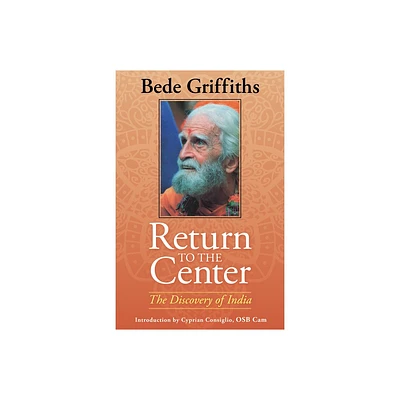Home
Return to The Center: Discovery of India
Loading Inventory...
Barnes and Noble
Return to The Center: Discovery of India
Current price: $28.00


Barnes and Noble
Return to The Center: Discovery of India
Current price: $28.00
Loading Inventory...
Size: Paperback
*Product Information may vary - to confirm product availability, pricing, and additional information please contact Barnes and Noble
A new edition of a classic work of spiritual discovery.
“I sit here on the veranda of my cell, watching the sun set behind the trees, and recall the day, nearly fifty years ago, when I watched the same suns setting over the playing-fields at school. My cell is a thatched hut surrounded by trees. I can listen to the birds singing as I did then, and watch the trees making dark patterns against the sky as the light fades, but I have travelled a long way both in space and time since then. . . .”
Bede Griffiths (1907-1993), a British-born Benedictine monk, moved to India in 1955, adopted the appearance of a Hindu
sannyasi
—one whose whole life is focused on the search for God—and became one of the great pioneers of East-West dialogue.
In
Return to the Center
Griffiths offers the fruits of a lifetime spent in prayer and meditation. He believes that modern humans have lost touch with the center of their own life, and therefore with life itself. This center is “the place of meeting where the different religious traditions of the world have their source, and the ultimate meaning of human existence is to be found. . . . For a Christian this is manifested in the person of Jesus Christ.” Griffiths illuminates the way for us each to find our own way back to the center by looking at the truths of Hinduism and Buddhism through a Christian lens. In these short reflections he reflects “on what India has done to me, on how my mind has developed, on the changes which have taken place in my way of life and in the depths of my soul.”
This edition is augmented by an additional chapter that narrates his move from England to India, describing what he was seeking and what he found. In addition, a lengthy introduction by
Cyprian Consiglio
, former prior of New Camaldoli Hermitage in Big Sur, offers a biographical profile of Griffiths and assesses his significance as a “Christocentric perrenialist.”
“I sit here on the veranda of my cell, watching the sun set behind the trees, and recall the day, nearly fifty years ago, when I watched the same suns setting over the playing-fields at school. My cell is a thatched hut surrounded by trees. I can listen to the birds singing as I did then, and watch the trees making dark patterns against the sky as the light fades, but I have travelled a long way both in space and time since then. . . .”
Bede Griffiths (1907-1993), a British-born Benedictine monk, moved to India in 1955, adopted the appearance of a Hindu
sannyasi
—one whose whole life is focused on the search for God—and became one of the great pioneers of East-West dialogue.
In
Return to the Center
Griffiths offers the fruits of a lifetime spent in prayer and meditation. He believes that modern humans have lost touch with the center of their own life, and therefore with life itself. This center is “the place of meeting where the different religious traditions of the world have their source, and the ultimate meaning of human existence is to be found. . . . For a Christian this is manifested in the person of Jesus Christ.” Griffiths illuminates the way for us each to find our own way back to the center by looking at the truths of Hinduism and Buddhism through a Christian lens. In these short reflections he reflects “on what India has done to me, on how my mind has developed, on the changes which have taken place in my way of life and in the depths of my soul.”
This edition is augmented by an additional chapter that narrates his move from England to India, describing what he was seeking and what he found. In addition, a lengthy introduction by
Cyprian Consiglio
, former prior of New Camaldoli Hermitage in Big Sur, offers a biographical profile of Griffiths and assesses his significance as a “Christocentric perrenialist.”


















